-ed -ing形容词
动词加ed和ing规则

动词过去式变化规则及其读音规则规则动词的过去式变化如下:1、一般情况下,动词词尾加-ed ,如:work ---worked play---play ed wanted----wanted act----acted2、以不发音的-e 结尾动词,动词词尾加-d,如:liv e---liv edmov e----mov edtaste---tasted hope---hoped3、以辅音字母+ y结尾的动词,把-y变为-i 再加-ed,如:study---studie d copy---copied cry---criedcarry---carrie d4、以一个辅音字母结尾的重读闭音节动词,双写词尾辅音字母,再加-ed,如:stop ---stoppe d5、不规则动词的过去式变化规律性不强,须多加记忆。
go – went make – made get – got buy- bought come - came f ly-flew不规则动词的过去式的构成1.把动词原形中的i改为a,变成过去式。
如:begin—began,drink—drank,giv e—gav e,ring—rang,sing—sang,sit—sat,swim—swam 2.把重读开音节中的i改为o,变成过去式。
如:driv e—drov e,ride—rode,write—wrote3.改动词原形中的aw /ow为ew,变成过去式。
如:draw—drew,grow—grew,know—knew,throw—threw(动词show除外,show—showed)4.动词原形中的e改为o,变成过去式。
如:get—got,f orget—f orgot5.动词原形中的ee改为e,变成过去式。
如:f eed—f ed,meet—met6.动词原形中的eep改为ept,变成过去式。
双写再加ed或ing的动词-加ed和ing的单词
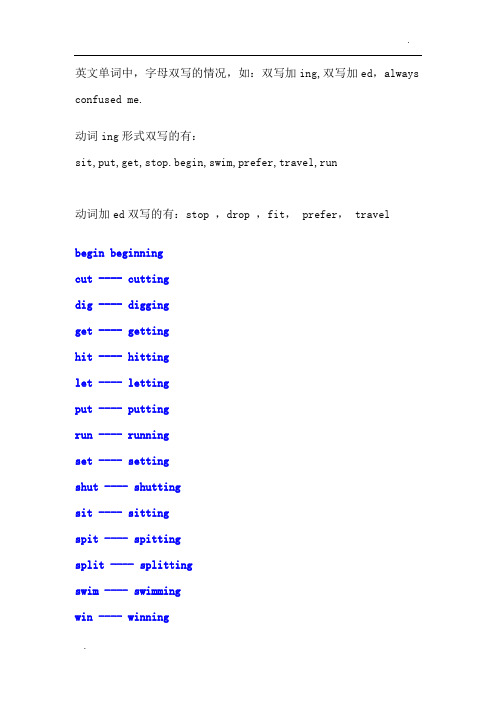
英文单词中,字母双写的情况,如:双写加ing,双写加ed,always confused me.动词ing形式双写的有:sit,put,get,stop.begin,swim,prefer,travel,run动词加ed双写的有:stop ,drop ,fit, prefer, travel begin beginningcut ---- cuttingdig ---- diggingget ---- gettinghit ---- hittinglet ---- lettingput ---- puttingrun ---- runningset ---- settingshut ---- shuttingsit ---- sittingspit ---- spittingsplit ---- splittingswim ---- swimmingwin ---- winningbeg ---- begged ---- beggingdrip ---- dripped ---- drippingdot ---- dotted ---- dottingdrop ---- dropped ---- droppingfit ---- fitted ---- fittinghug ---- hugged ---- huggedplan ---- planned ---- planningpat ---- patted ---- pattingrid ---- ridded ---- riddingrob ---- robbed ---- robbingrebet ---- rebetted ---- rebettingregret ---- regretted ---- regrettingstop ---- stopped ---- stoppingstir ---- stirred ---- stirringrub ---- rubbed ---- rubbingtravel ---- travel(l)ed ---- travel(l)ingwhip ---- whipped ---- whipping规则是:在重读闭音节里,末尾只有一个辅音字母,辅音字母前只有一个元音字母时,要双写这个辅音字母。
英语语法解析 动词-ing形式与动词-ed形式的区别
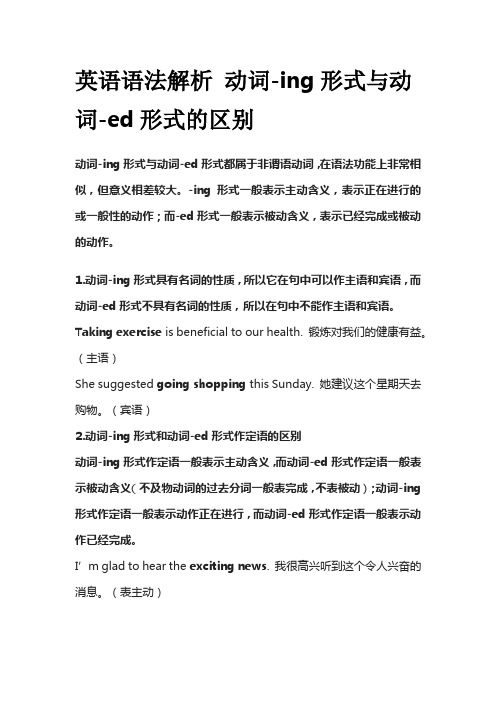
英语语法解析动词-ing形式与动词-ed形式的区别动词-ing形式与动词-ed形式都属于非谓语动词,在语法功能上非常相似,但意义相差较大。
-ing形式一般表示主动含义,表示正在进行的或一般性的动作;而-ed形式一般表示被动含义,表示已经完成或被动的动作。
1.动词-ing形式具有名词的性质,所以它在句中可以作主语和宾语,而动词-ed形式不具有名词的性质,所以在句中不能作主语和宾语。
Taking exercise is beneficial to our health. 锻炼对我们的健康有益。
(主语)She suggested going shopping this Sunday. 她建议这个星期天去购物。
(宾语)2.动词-ing形式和动词-ed形式作定语的区别动词-ing形式作定语一般表示主动含义,而动词-ed形式作定语一般表示被动含义(不及物动词的过去分词一般表完成,不表被动);动词-ing 形式作定语一般表示动作正在进行,而动词-ed形式作定语一般表示动作已经完成。
I’m glad to hear the exciting news. 我很高兴听到这个令人兴奋的消息。
(表主动)The cat drawn by the boy was very lovely. 男孩画的猫非常可爱。
(表被动)The ground was covered fallen leaves. 地上覆盖着落叶。
(不及物动词表完成)The rising sun is a symbol of hope. 冉冉升起的太阳象征着希望。
(表动作正在进行)They looked up at the risen sun. 他们仰望着已升起的太阳。
(表动作完成)3.动词-ing形式和动词-ed形式作表语的区别动词-ing形式作表语一般表示主语的性质和特征,含义为“令人……”;动词-ed形式作表语一般表示人的感受,含义为“(某人)感觉……”。
动词-ed形式和-ing形式区别
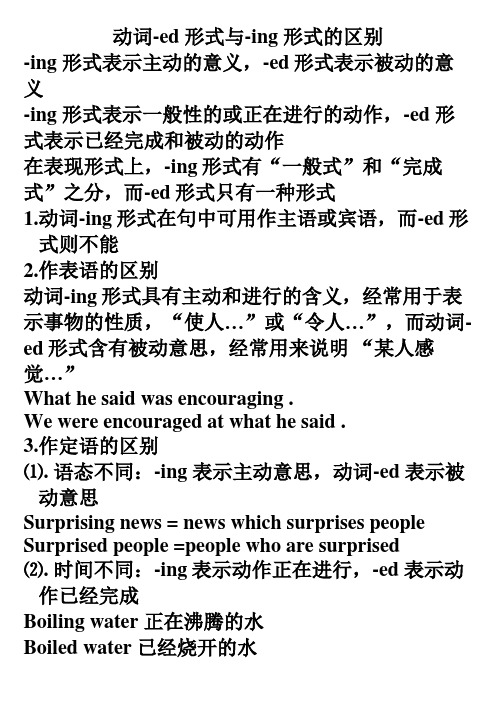
动词-ed 形式与-ing 形式的区别-ing 形式表示主动的意义,-ed形式表示被动的意义-ing 形式表示一般性的或正在进行的动作,-ed 形式表示已经完成和被动的动作在表现形式上,-ing形式有“一般式”和“完成式”之分,而-ed形式只有一种形式1.动词-ing形式在句中可用作主语或宾语,而-ed形式则不能2.作表语的区别动词-ing形式具有主动和进行的含义,经常用于表示事物的性质,“使人…”或“令人…”,而动词-ed形式含有被动意思,经常用来说明“某人感觉…”What he said was encouraging .We were encouraged at what he said .3.作定语的区别⑴.语态不同:-ing 表示主动意思,动词-ed 表示被动意思Surprising news = news which surprises people Surprised people =people who are surprised⑵.时间不同:-ing表示动作正在进行,-ed 表示动作已经完成Boiling water 正在沸腾的水Boiled water 已经烧开的水4.作宾语补足语的区别⑴.语态不同:及物动词的-ed形式作宾语补足语时,表示被动,说明宾语是-ed形式动作的承受者,而-ing形式作宾语补足语时,表示主动,说明宾语是补足语的动作的执行者.I often hear the song sung in EnglishI often hear people singing the song.⑵.时间不同;有些动词-ed形式作宾语补足语时,常表示动作已经完成或动作发生在谓语动词之前,-ing形式作宾语补足语时,则表示动作正在进行When I got home , I found my wallet lostWhen I came here ,I found Wanglei reading an English book.。
用作状语的-ed分词[整理版]
![用作状语的-ed分词[整理版]](https://img.taocdn.com/s3/m/cfdb102442323968011ca300a6c30c225901f012.png)
用作状语的-ED分词—、用作状语的-ED分词这样的-ed分词通常来自及物动词。
-ed分词用作状语时,跟-ing分词作状语时一样,修饰主句的谓语动词,意义上相当于状语从句,表示时间,条件,原因,伴随状况等。
-ed分词结构作状语,前边往往可以加when, while, if, as if, though。
这时,我们可以把-ed分词结构理解为一个省略句,即省去了“主语和be的变化形式”。
一般说来,这种结构的逻辑主语必须与主句的主语一致。
-ed分词作状语跟-ing作状语一样,修饰主句的谓语动词,意义上相当于状语从句,表示时间、原因、条件、伴随状况等。
1.表示时间Seen from a distance, the mountain looked like a lion.从远处看,这座山脉象一头狮子。
2.表示原因Criticized unfairly, she left the office without saying a word.由于受到不公平的批评,她默默地离开了办公室。
3.表示条件Watered once a day, the flower will grow very well.如果每天浇一次水,这花会长得很好。
4.表示伴随状况He stood there, fascinated by the singing.他站在那儿,被歌声所吸引。
在句子深层结构中,-ed分词短语的逻辑主语就是句子的主语。
如果-ed分词短语的逻辑主语与句子的主语不一致,-ed分词短语的逻辑主语则需要用一个独立结构或者用一个由with/without等引导的介词短语表达出来。
如:The question settled, they left for home.问题解决了,他们就回家了。
With everything taken into consideration, we all think this is a good suggestion.统观全局,我们认为这是一个好的提议。
动词-ed形式作定语
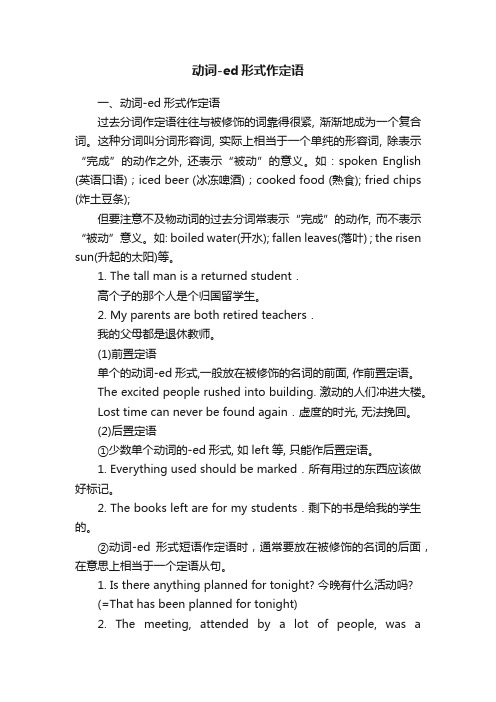
动词-ed形式作定语一、动词-ed形式作定语过去分词作定语往往与被修饰的词靠得很紧, 渐渐地成为一个复合词。
这种分词叫分词形容词, 实际上相当于一个单纯的形容词, 除表示“完成”的动作之外, 还表示“被动”的意义。
如:spoken English (英语口语);iced beer (冰冻啤酒);cooked food (熟食); fried chips (炸土豆条);但要注意不及物动词的过去分词常表示“完成”的动作, 而不表示“被动”意义。
如: boiled water(开水); fallen leaves(落叶) ; the risen sun(升起的太阳)等。
1. The tall man is a returned student.高个子的那个人是个归国留学生。
2. My parents are both retired teachers.我的父母都是退休教师。
(1)前置定语单个的动词-ed形式,一般放在被修饰的名词的前面, 作前置定语。
The excited people rushed into building. 激动的人们冲进大楼。
Lost time can never be found again.虚度的时光, 无法挽回。
(2)后置定语①少数单个动词的-ed形式, 如left等, 只能作后置定语。
1. Everything used should be marked.所有用过的东西应该做好标记。
2. The books left are for my students.剩下的书是给我的学生的。
②动词-ed形式短语作定语时,通常要放在被修饰的名词的后面,在意思上相当于一个定语从句。
1. Is there anything planned for tonight? 今晚有什么活动吗?(=That has been planned for tonight)2. The meeting, attended by a lot of people, was asuccess.这次会议有很多人出席, 开得很成功。
ed的发音规则
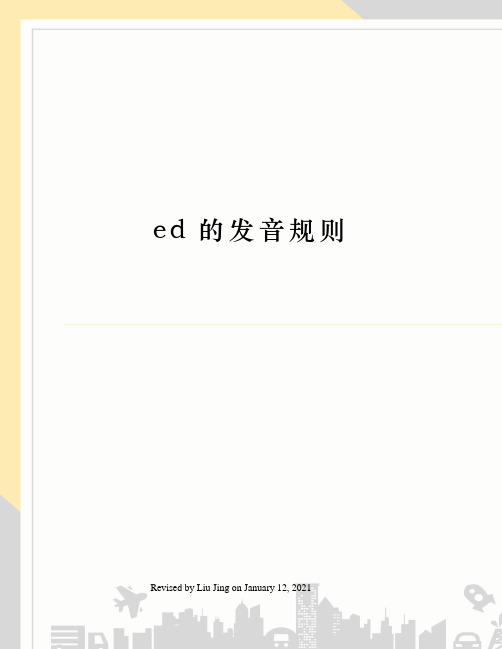
e d的发音规则 Revised by Liu Jing on January 12, 20211.加e d以后的发音有如下三种:1) ed 在清辅音 [p][t][k][f][s][h]等后读[ t ]如:helped, washed, watched, marked, finished, stopped, skipped, cooked, worked2)ed 在浊辅音 [d][g][v][z][r][m][n]等后及元音后读[d],如:cleaned, played, prepared3)ed在[t][d]后读[id] ,如:painted, started, visited2.频率副词的位置一般是放在句子中间,此时应该是:be动词、情态动词、助动词之后,行为动词之前。
另外,sometimes, often 也可以放在句首以及句尾,但是often放在句尾时,前面通常要有very,quite等修饰语。
usually有时也可以放在句首3.句子成分知识根据英语词汇在英语句子中的地位和作用, 英语句子的成分可分为主语、谓语、宾语、宾语补足语、表语、定语、状语、同位语及独立成分等。
其中,主语和谓语是句子的主要成分,一般情况下,一个句子不能缺少这两种成分。
1)主语:表示句子所要说明或描述的人或事物,一般由名词、代词或相当于名词的词组或句子充当,置于句首。
如:It’s getting cold. 天冷起来了。
The teacher is very kind to us. 老师对我们很好。
2)谓语:说明或描述主语的动作、状态或特征,由动词或动词短语充当,位于主语之后。
如:Mother bought me a VCR. 妈给我买了一台录像机。
We have finished our work already. 我们已经完成了工作。
3)表语:表示主语的身份、性质、状态和特征,一般由名词、形容词、或相当于名词、形容词的词、短语或句子充当,位于连系动词之后,与连系动词一起构成句子的谓语。
(完整版)动词-ed形式和-ing形式区别
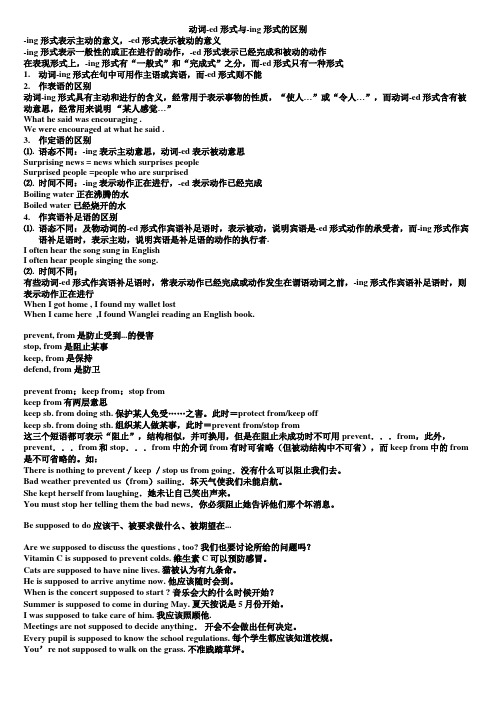
动词-ed 形式与-ing 形式的区别-ing 形式表示主动的意义,-ed形式表示被动的意义-ing 形式表示一般性的或正在进行的动作,-ed 形式表示已经完成和被动的动作在表现形式上,-ing形式有“一般式”和“完成式”之分,而-ed形式只有一种形式1.动词-ing形式在句中可用作主语或宾语,而-ed形式则不能2.作表语的区别动词-ing形式具有主动和进行的含义,经常用于表示事物的性质,“使人…”或“令人…”,而动词-ed形式含有被动意思,经常用来说明“某人感觉…”What he said was encouraging .We were encouraged at what he said .3.作定语的区别⑴.语态不同:-ing 表示主动意思,动词-ed 表示被动意思Surprising news = news which surprises peopleSurprised people =people who are surprised⑵.时间不同:-ing表示动作正在进行,-ed 表示动作已经完成Boiling water 正在沸腾的水Boiled water 已经烧开的水4.作宾语补足语的区别⑴.语态不同:及物动词的-ed形式作宾语补足语时,表示被动,说明宾语是-ed形式动作的承受者,而-ing形式作宾语补足语时,表示主动,说明宾语是补足语的动作的执行者.I often hear the song sung in EnglishI often hear people singing the song.⑵.时间不同;有些动词-ed形式作宾语补足语时,常表示动作已经完成或动作发生在谓语动词之前,-ing形式作宾语补足语时,则表示动作正在进行When I got home , I found my wallet lostWhen I came here ,I found Wanglei reading an English book.prevent, from是防止受到...的侵害stop, from 是阻止某事keep, from 是保持defend, from 是防卫prevent from;keep from;stop fromkeep from有两层意思keep sb. from doing sth. 保护某人免受……之害。
非谓语动词之动词的-ed形式
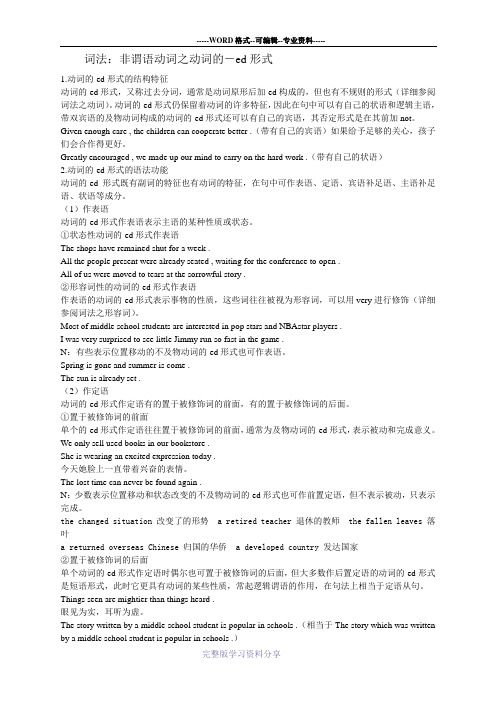
词法:非谓语动词之动词的-ed形式1.动词的-ed形式的结构特征动词的-ed形式,又称过去分词,通常是动词原形后加-ed构成的,但也有不规则的形式(详细参阅词法之动词)。
动词的-ed形式仍保留着动词的许多特征,因此在句中可以有自己的状语和逻辑主语,带双宾语的及物动词构成的动词的-ed形式还可以有自己的宾语,其否定形式是在其前加not。
Given enough care , the children can cooperate better .(带有自己的宾语)如果给予足够的关心,孩子们会合作得更好。
Greatly encouraged , we made up our mind to carry on the hard work .(带有自己的状语)2.动词的-ed形式的语法功能动词的-ed形式既有副词的特征也有动词的特征,在句中可作表语、定语、宾语补足语、主语补足语、状语等成分。
(1)作表语动词的-ed形式作表语表示主语的某种性质或状态。
①状态性动词的-ed形式作表语The shops have remained shut for a week .All the people present were already seated , waiting for the conference to open .All of us were moved to tears at the sorrowful story .②形容词性的动词的-ed形式作表语作表语的动词的-ed形式表示事物的性质,这些词往往被视为形容词,可以用very进行修饰(详细参阅词法之形容词)。
Most of middle school students are interested in pop stars and NBAstar players .I was very surprised to see little Jimmy run so fast in the game .N:有些表示位置移动的不及物动词的-ed形式也可作表语。
ed的发音规则
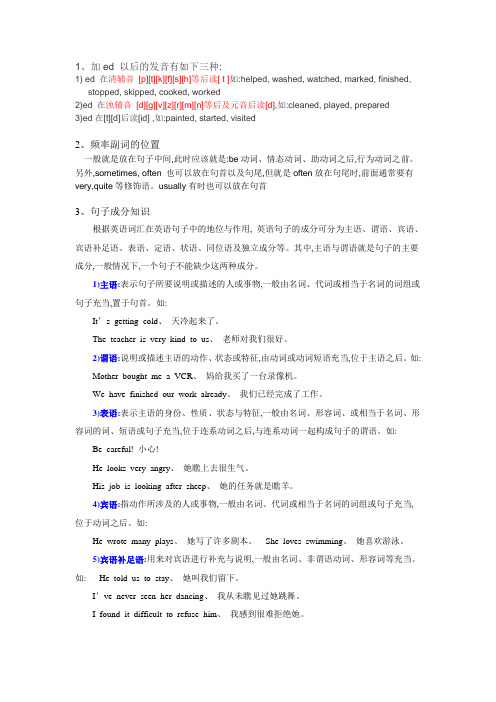
1、加ed 以后的发音有如下三种:1) ed 在清辅音[p][t][k][f][s][h]等后读[ t ]如:helped, washed, watched, marked, finished,stopped, skipped, cooked, worked2)ed 在浊辅音[d][g][v][z][r][m][n]等后及元音后读[d],如:cleaned, played, prepared3)ed在[t][d]后读[id] ,如:painted, started, visited2、频率副词的位置一般就是放在句子中间,此时应该就是:be动词、情态动词、助动词之后,行为动词之前。
另外,sometimes, often 也可以放在句首以及句尾,但就是often放在句尾时,前面通常要有very,quite等修饰语。
usually有时也可以放在句首3、句子成分知识根据英语词汇在英语句子中的地位与作用, 英语句子的成分可分为主语、谓语、宾语、宾语补足语、表语、定语、状语、同位语及独立成分等。
其中,主语与谓语就是句子的主要成分,一般情况下,一个句子不能缺少这两种成分。
1)主语:表示句子所要说明或描述的人或事物,一般由名词、代词或相当于名词的词组或句子充当,置于句首。
如:It’s getting cold、天冷起来了。
The teacher is very kind to us、老师对我们很好。
2)谓语:说明或描述主语的动作、状态或特征,由动词或动词短语充当,位于主语之后。
如:Mother bought me a VCR、妈给我买了一台录像机。
We have finished our work already、我们已经完成了工作。
3)表语:表示主语的身份、性质、状态与特征,一般由名词、形容词、或相当于名词、形容词的词、短语或句子充当,位于连系动词之后,与连系动词一起构成句子的谓语。
如: Be careful! 小心!He looks very angry、她瞧上去很生气。
高中英语be+v-ed+介词做状语用法总结
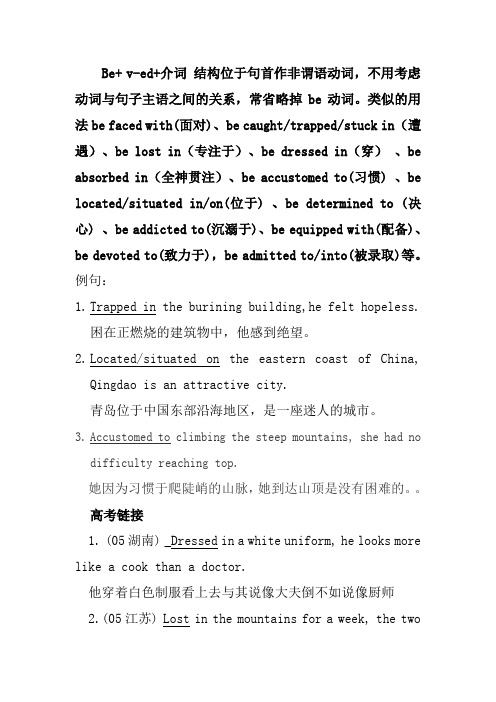
Be+ v-ed+介词结构位于句首作非谓语动词,不用考虑动词与句子主语之间的关系,常省略掉be动词。
类似的用法be faced with(面对)、be caught/trapped/stuck in(遭遇)、be lost in(专注于)、be dressed in(穿)、be absorbed in(全神贯注)、be accustomed to(习惯) 、be located/situated in/on(位于) 、be determined to (决心) 、be addicted to(沉溺于)、be equipped with(配备)、be devoted to(致力于),be admitted to/into(被录取)等。
例句:1.Trapped in the burining building,he felt hopeless.困在正燃烧的建筑物中,他感到绝望。
2.Located/situated on the eastern coast of China,Qingdao is an attractive city.青岛位于中国东部沿海地区,是一座迷人的城市。
3.difficulty reaching top.她因为习惯于爬陡峭的山脉,她到达山顶是没有困难的。
高考链接1. (05湖南) _Dressed in a white uniform, he looks more like a cook than a doctor.他穿着白色制服看上去与其说像大夫倒不如说像厨师2.(05江苏) Lost in the mountains for a week, the twostudents were finally saved by the local police .两名学生在山中迷路一个星期,最终被当地警察营救。
3.(06四川) Faced with so much trouble, we failed to complete the task on time.我们面临那么多的困难,没有准时完成任务。
动词加-ing、-ed,-es的规则

动词加-ing, -s/ -es, -ed及名词加-s /-es的规则汇总一动词+ing:1 一般情况下,直接在动词后加-ing2 动词以不发音的-e结尾,要去-e加-ing3 重读闭音节并且是由一个元音字母加一个辅音字母结尾的动词,要双写辅音字母再加-ing4 以-ie结尾的动词,把-ie变成y再加-ingwork _______ study _______ take _______make _______ cut _______ put _______begin _______ lie _______ tie _______ die _______二动词+s / es (名词变复数的规则相同!)1 一般情况下,在动词后+s2 以辅音字母+y结尾的动词,把y改为i,再加es (元音字母+y的单词直接加s)3 以s, x, ch,sh, o结尾的动词加es. (以o结尾的名词,一般下面的词加es:Negro—Negroes 、hero—heroes 、tomato—tomatoes 、potato—potatoes )get_______ s tay________ watch_______ w ish_______fix_______ do _________ go_______ pass_______try_______ study_______ c ry_______ fly_________三动词+ed:1 一般情况下,动词词尾加ed (以e结尾的单词只要加d就可以了)2 以辅音字母+ y结尾的动词,把y变为i 再加ed,3 以一个辅音字母结尾的重读闭音节动词,双写词尾辅音字母,再加ed,live_______ move_______ judge_______ wipe_______study_______ copy_______ cry_______ carry_______empty_______ stop_______ beg_______ drag_______drop_______ plan_______ drip_______答案:一:working studying taking making cutting putting beginning lying tying dying二:gets stays watches wishes fixes doesgoes passes tries studies cries flies三:lived moved judged wiped studied copiedcried carried emptied stopped begged draggeddropped planned dripped【本文档内容可以自由复制内容或自由编辑修改内容期待你的好评和关注,我们将会做得更好】。
英语名词加ed变形容词规则
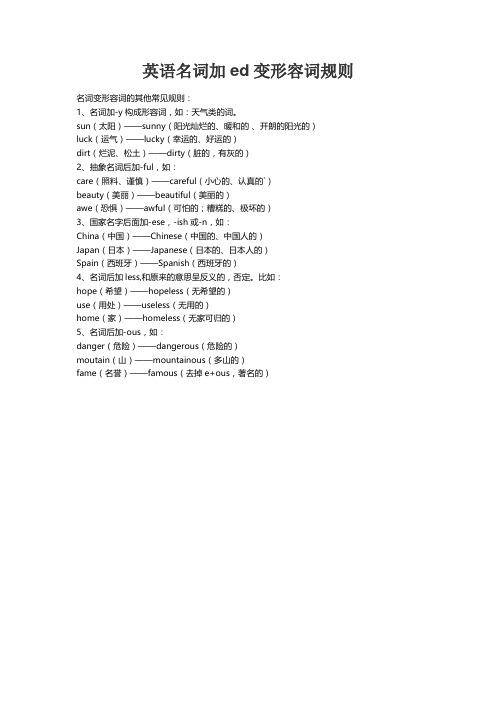
英语名词加ed变形容词规则
名词变形容词的其他常见规则:
1、名词加-y构成形容词,如:天气类的词。
sun(太阳)——sunny(阳光灿烂的、暖和的、开朗的阳光的)
luck(运气)——lucky(幸运的、好运的)
dirt(烂泥、松土)——dirty(脏的,有灰的)
2、抽象名词后加-ful,如:
care(照料、谨慎)——careful(小心的、认真的`)
beauty(美丽)——beautiful(美丽的)
awe(恐惧)——awful(可怕的;糟糕的、极坏的)
3、国家名字后面加-ese,-ish或-n,如:
China(中国)——Chinese(中国的、中国人的)
Japan(日本)——Japanese(日本的、日本人的)
Spain(西班牙)——Spanish(西班牙的)
4、名词后加less,和原来的意思呈反义的,否定。
比如:
hope(希望)——hopeless(无希望的)
use(用处)——useless(无用的)
home(家)——homeless(无家可归的)
5、名词后加-ous,如:
danger(危险)——dangerous(危险的)
moutain(山)——mountainous(多山的)
fame(名誉)——famous(去掉e+ous,著名的)。
ed的发音规则
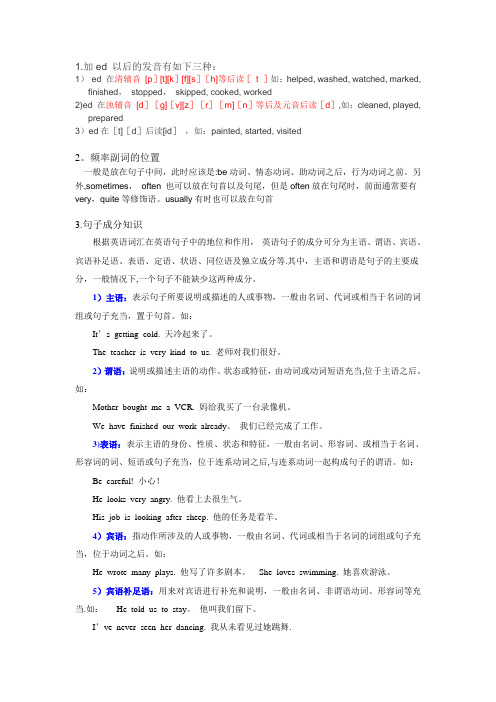
1.加ed 以后的发音有如下三种:1)ed 在清辅音[p][t][k][f][s][h]等后读[t ]如:helped, washed, watched, marked, finished,stopped,skipped, cooked, worked2)ed 在浊辅音[d][g][v][z][r][m][n]等后及元音后读[d],如:cleaned, played,prepared3)ed在[t][d]后读[id],如:painted, started, visited2。
频率副词的位置一般是放在句子中间,此时应该是:be动词、情态动词、助动词之后,行为动词之前。
另外,sometimes,often 也可以放在句首以及句尾,但是often放在句尾时,前面通常要有very,quite等修饰语。
usually有时也可以放在句首3.句子成分知识根据英语词汇在英语句子中的地位和作用,英语句子的成分可分为主语、谓语、宾语、宾语补足语、表语、定语、状语、同位语及独立成分等.其中,主语和谓语是句子的主要成分,一般情况下,一个句子不能缺少这两种成分。
1)主语:表示句子所要说明或描述的人或事物,一般由名词、代词或相当于名词的词组或句子充当,置于句首。
如:It’s getting cold. 天冷起来了。
The teacher is very kind to us. 老师对我们很好。
2)谓语:说明或描述主语的动作、状态或特征,由动词或动词短语充当,位于主语之后。
如:Mother bought me a VCR. 妈给我买了一台录像机。
We have finished our work already。
我们已经完成了工作。
3)表语:表示主语的身份、性质、状态和特征,一般由名词、形容词、或相当于名词、形容词的词、短语或句子充当,位于连系动词之后,与连系动词一起构成句子的谓语。
如:Be careful! 小心!He looks very angry. 他看上去很生气。
- 1、下载文档前请自行甄别文档内容的完整性,平台不提供额外的编辑、内容补充、找答案等附加服务。
- 2、"仅部分预览"的文档,不可在线预览部分如存在完整性等问题,可反馈申请退款(可完整预览的文档不适用该条件!)。
- 3、如文档侵犯您的权益,请联系客服反馈,我们会尽快为您处理(人工客服工作时间:9:00-18:30)。
ing形式和ed形式
一般来说,动词的ing形式和ed形式都可以用来做形容词。
ing形式是用来形容事物的,意为:令人(感到)……,使人(感到)……。
而ed形式是用来形容人的,意为:(人)(感到)……。
例如:
I was excited when I got the exciting news.
当我听到这个令人兴奋的消息,我很高兴/兴奋。
⑴interest v. 使.......感兴趣
interesting adj. 令人感兴趣的
interested adj. 感兴趣的
⑵relax relaxing relaxed ⑶please pleasing pleased ⑷bore
boring
bored
⑸surprise surprising surprised ⑹excite Exciting Excited ⑺annoy annoying annoyed ⑻confuse confusing confused ⑼disgust
disgusting
disgusted ⑽thrill thrilling thrilled
⑾exhaust exhausting exhausted
⑿embarrass embarrassing embarrassed ⒀fascinate
fascinating
Fascinated ⒁worry worrying worried
⒂frighten frightening frightened
1.The sight of the boat going under water was __________ ( worry)
2. Huck got _______ (excite) when he realized there was someone on the boat.
3. The men with the gun had a ________ (satisfy) expression in his face.
4. The man on the floor was clearly ___________ (frighten) .
5. Huck and Jim had lots of ___________ (frighten)experiences on the river.
6. I didn’t know you were ___________ (interest) in Mark Twain.
7. Yes, I find his novels very ________ (excite)
8. Twain certainly had an unusual and ____________ (interest) life.
1.The computer game is ______ and many children are ______ in it.
A.interest,interesting
B.interested,interesting
C.interesting,interested
D.interest,interested
2.---Kangkang watched an _______ movie and went to bed late last night.
---Now she feels a little _______.
A.excited,tiring
B.exciting,tiring
C.excited,tired
D.exciting,tired
3.The football match was so ______ that the boy was too ______ to fall asleep.
A.excited,exciting
B.exciting,excited
C.exciting,exciting
D.excited,excited。
